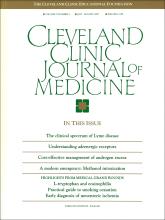ABSTRACT
The most common signs of androgen excess in women are acne, alopecia, and hirsutism. Less common manifestations include android obesity, virilization, and acanthosis nigricans. These changes appear to be the result of excessive androgen production or increased target organ sensitivity. To evaluate excessive androgen production, an androgen screening protocol is recommended that includes measurement of dehydroepiandrosterone sulfate, testosterone, androstenedione, prolactin, follicular stimulating hormone, and luteinizing hormone. When androgen excess is confirmed, dexamethasone suppression is recommended to determine the source of the androgen(s). Once excessive androgen production is confirmed, more specific therapies can be administered.
- Copyright © 1990 The Cleveland Clinic Foundation. All Rights Reserved.






